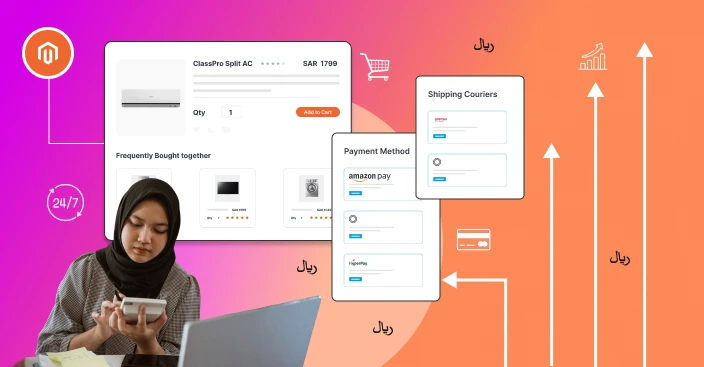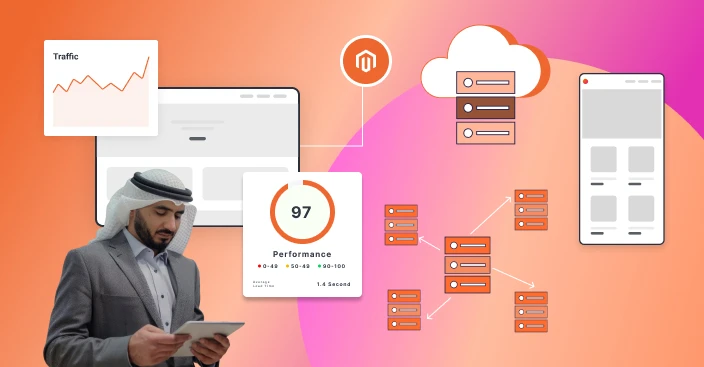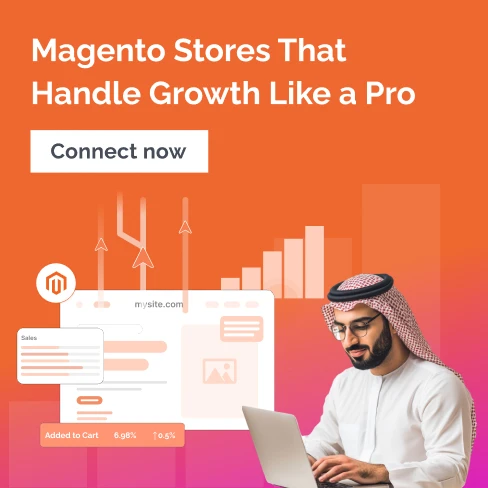How to Build a Scalable Magento Store for the Upcoming Saudi eCommerce Market in 2025

Since Saudi Arabia’s eCommerce economy is still on the rise, there is no choice but to play catch-up quickly.
As the Kingdom’s Vision 2030 speeds ahead with digitalisation and increasingly tech-savvy consumers, Magento is a great, adaptable platform to expand and future-proof your online business.
This blog will discuss building an elastic Magento store that adapts to the changing Saudi marketplace by 2025.
Explore the Saudi eCommerce Trends in 2025
The Digital Transformation in Saudi Arabia is changing. According to a recent report, the eCommerce revenues in the Saudi were over SAR 50 billion in 2023, and the figure is expected to rise even further until 2025. Hence, this is the most crucial time for Saudi Arabia.
As mobile phone penetration, web penetration, and state-driven digitalisation pick up pace, the eCommerce industry is ready to take off.
Online ventures must invest in a scalable and high-performance platform that can match evolving customer needs—Magento does just that.
Why Magento Is Perfect for the Saudi Market
Magento development (Known as Adobe Commerce) is a renowned and useful platform for providing unparalleled flexibility and scalability.
This is the reason it’s become the preferred choice for enterprises and rapidly expanding brands.
As an open-source platform, it is fully customisable so that brands may cater to local tastes, support Arabic languages, and regional shipping and payment methods.
Magento’s multistore functionality is also ideal for business growth through GCC nations, where centralised control enables localised experiences.
Step-by-Step Guide to Creating a Scalable Magento Store in Saudi Arabia
Let us see what it involves to create a high-performing Magento store that is well-optimised for Saudi market expansion.
Start with a Solid Infrastructure
Scalability begins at the foundation. The brand needs to choose the flexible, secure and fast cloud hosting services.
Choosing Magneto will help boost the auto-scaling, which can help share the extreme load and data backup capabilities to handle unexpected visitor spikes, specifically during major sales events like White Friday or Ramadan.
Investment in Content Delivery Networks such as Cloudflare or Fastly also allows pages to load promptly in the Saudi cities of Riyadh, Jeddah, and Dammam.
Optimisation for Mobile-First Commerce
Over 90% of Saudis access the internet via mobile, and hence your Magento site must have an unbroken mobile experience.
Implement responsive themes or Progressive Web App (PWA) deployment to offer app-like speed and functionality.
PWAs are also especially handy in a region where data connectivity is poor; they allow customers to shop offline and pre-load content faster, which reduces bounce rates significantly.
65% of online shoppers in the Middle East appreciate tailoring and mobile-first shopping, both of which Magento supports natively.

Personalise the Shopping Experience
Saudi Arabian customers are highly sensitive to personalisation. Your sophisticated AI and machine learning features in Magento—through Adobe Sensei—can help you present dynamic content, product recommendations, and promotions triggered by user behaviour.
Include widgets like Algolia for intelligent search or Emarsys for omnichannel marketing automation to infuse more engagement and retention.
Include Local Payment and Shipping Gateways
To ensure customer trust, offer well-known and established payment methods like Mada, STC Pay, Tabby, and Tamara, which are highly acceptable in all parts of Saudi Arabia.
Magento supports these services natively via APIs or third-party extensions. At delivery, integrate your store with leading logistics partners like Aramex, SMSA Express, and Saudi Post.
Real-time tracking of parcels, COD service, and return policies with complete transparency will contribute a lot to customer satisfaction.
Implement a Scalable Product Catalogue Management
With your growing business, maintaining a huge inventory of products can become challenging. Magento’s product management module helps you to categorise, label, and filter SKUs within stores with minimal effort.
Utilise custom attributes and layered navigation to maximise customer experience and enhance search functionality.
Advanced stock management capabilities like Magento MSI (Multi-Source Inventory) help track inventory anywhere across warehouses or fulfilment centres in different locations within Saudi Arabia.
RTL and Arabic Language Support
Your local customers need to be native to your shop. Magento includes full Arabic language support, from right-to-left (RTL) layout, Arabic numbers, and local date formats.
Localise, don’t translate—your content to the Saudi people. You would need to hire native speakers or localisation experts to get your store to speak your customers’ language—literally and culturally.
Scalable Security Investment
It is not an option for Saudi Arabia to invest more in cybersecurity; compliance for your Magento store is a necessity.
It comes with major security measures such as two-factor authentication, role-based access control, and PCI-validated payment integration.
Therefore, implementing this platform means maintaining extensions, performing vulnerability scanning, and implementing web application firewalls (WAFs) to protect user information and build trust.

Make use of Magento Extensions and Custom APIs
Differentiate your company in a competitive market by using the right extensions and APIs to customise your store.
Magento’s open-source nature enables you to add loyalty schemes, subscription billing, AI-based chatbots, and more.
If you are selling goods to niche markets (such as men’s fashion, health supplements), Magento supports building customised workflows and experiences for the price of nothing but performance.
Turn on Real-Time Analytics and Reporting
With the help of a Magento store, the brands can get real-time analytics to allow you to track it all sales retail trends to user activity.
Besides, along with your current platform integrating with analytics tools like Google Analytics 4, Adobe Analytics can be helpful to ensure better visual performance to make in-the-moment adjustments.
These findings will help you convert better. Adobe Commerce asserts that businesses using Magento have experienced a growth in conversion rate up to 3x faster.
Additionally, it’s helped with cart abandonment and increased average order value, critical metrics to measure long-term growth in Saudi Arabia.
Future Growth through Omnichannel Integration
Successful Saudi eCommerce merchants in 2025 will connect the offline and online world.
Magento enables selling omnichannel to marketplaces like Amazon.sa, Noon, and social media channels like Instagram Shop and Snapchat.
Sync inventory in-store, offer click-and-collect functionality, and merge customer data to offer a consistent brand experience. Integration is important because customer expectations are evolving.
Conclusion
Magento is not just a platform; it is future-proofed. In creating a scalable Magento store optimised for Saudi Arabia’s digital consumers, you create new revenue streams, customer retention, and business agility over the long term.
With the Saudi market growing more competitive in 2025, the choice of the right technology partner is critical.
According to Statista, by 2025, the GCC eCommerce market is expected to reach USD 50 billion, with Saudi Arabia supplying more than half of that total.
Whether opening your first store or opening an existing one, Magento offers the resources and flexibility to drive your growth objectives straight away. Connect with a Magento expert for better implementation.
FAQ
Q1. Why is Magento such a powerful platform choice for the Saudi eCommerce market in 2025?
Magento provides flexibility, scalability, and localizability features most ideally suited to the developing Saudi eCommerce market.
Q2. What does it mean to create a “scalable” Magento store in Saudi Arabia?
It means to build a store with the capacity to accommodate increased traffic, product listings, and orders without losing performance.
Q3. What local integrations will my Magento store require for the Saudi audience?
You may include local payment gateways (such as STC Pay, Mada) and shipping carriers (like Aramex, SMSA).
Q4. How do I make my Magento store mobile responsive in KSA?
Use a flexible theme that is optimised for mobile devices, evaluate with widely used Saudi Arabian phones, and optimise for rapid loading.
Q5. How can I get my Magento store ready for products so that it can grow with my increasing sales?
Use cloud infrastructure, turn on caching, optimise databases, and spend on recurring performance audits.




